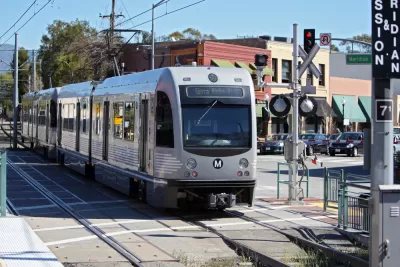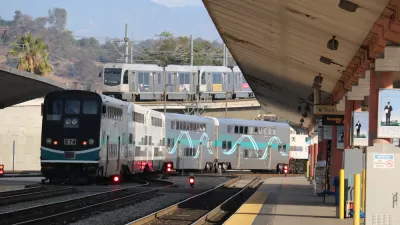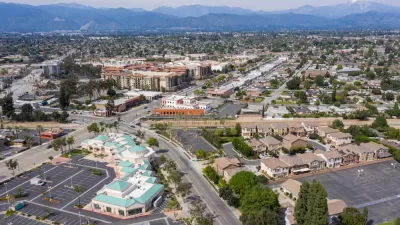Light rail transit only recently arrived in its contemporary form to the San Gabriel Valley—first to Pasadena in 2003 before heading further east into the valley in 2016. The future of public transit modes in the region are still under negotiation.

The San Gabriel Valley Council of Governments, the regional planning authority for a sprawling, populous swatch of Southern California, is ramping up its transit planning efforts, with the recent release of a "San Gabriel Valley Transit Feasibility Strategy" that includes 15 possible mass transit routes through the region.
Kristopher Fortin broke the news of the proposed transit alternatives for Streetsblog LA and provided a summary of the strategy's proposals. The strategy proposes eight potential east-west routes and seven north-south routes. "The modes being considered include a rapid bus that runs in mixed traffic lanes, express bus, bus rapid transit (BRT), light rail, and commuter rail," according to Fortin.
Fortin reported on the feasibility strategy in December 2020, when the work emerged from the ashes of a failed proposal to extend a light rail line (the L Line née Gold Line) along an alignment shared by State Highway 60, which connects Downtown Los Angeles to destinations farther east.
The Metro Board instead chose the Washington Boulevard alignment, but also "allocated $1.5 million toward the feasibility study, expected to determine how to spend $635 million in Measures M funds that had been set aside for the SGV L Line extension, but could shift to other SGV transit projects."
As noted by Fortin, the feasibility strategy is soliciting public feedback, although the survey does not ask questions specifically about the 15 route alternatives.
FULL STORY: Study Maps 15 Alternatives for New San Gabriel Valley Transit Investment

Alabama: Trump Terminates Settlements for Black Communities Harmed By Raw Sewage
Trump deemed the landmark civil rights agreement “illegal DEI and environmental justice policy.”

Study: Maui’s Plan to Convert Vacation Rentals to Long-Term Housing Could Cause Nearly $1 Billion Economic Loss
The plan would reduce visitor accommodation by 25% resulting in 1,900 jobs lost.

Why Should We Subsidize Public Transportation?
Many public transit agencies face financial stress due to rising costs, declining fare revenue, and declining subsidies. Transit advocates must provide a strong business case for increasing public transit funding.

Wind Energy on the Rise Despite Federal Policy Reversal
The Trump administration is revoking federal support for renewable energy, but demand for new projects continues unabated.

Passengers Flock to Caltrain After Electrification
The new electric trains are running faster and more reliably, leading to strong ridership growth on the Bay Area rail system.

Texas Churches Rally Behind ‘Yes in God’s Back Yard’ Legislation
Religious leaders want the state to reduce zoning regulations to streamline leasing church-owned land to housing developers.
Urban Design for Planners 1: Software Tools
This six-course series explores essential urban design concepts using open source software and equips planners with the tools they need to participate fully in the urban design process.
Planning for Universal Design
Learn the tools for implementing Universal Design in planning regulations.
Caltrans
Smith Gee Studio
Institute for Housing and Urban Development Studies (IHS)
City of Grandview
Harvard GSD Executive Education
Toledo-Lucas County Plan Commissions
Salt Lake City
NYU Wagner Graduate School of Public Service




























